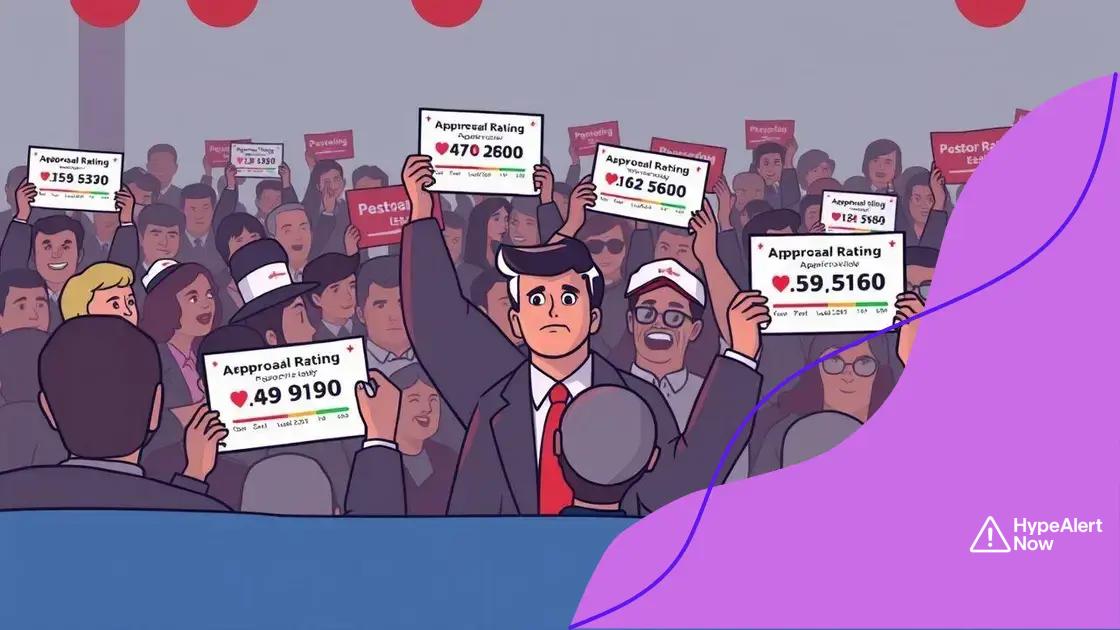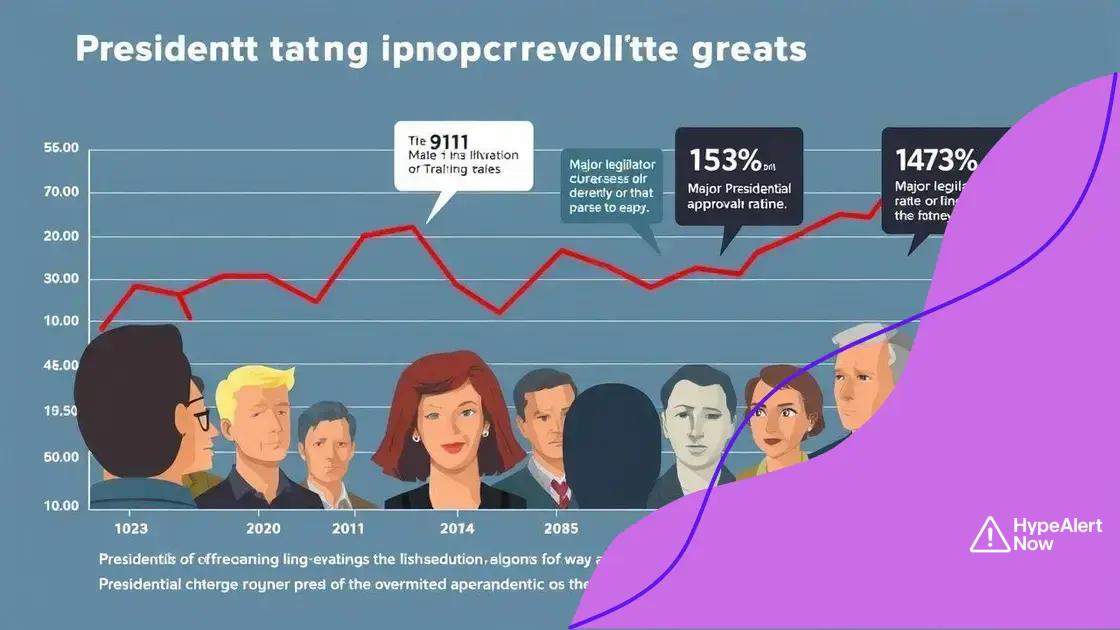Shifts in presidential approval ratings: What to expect

Shifts in presidential approval ratings are influenced by economic conditions, media coverage, and voter responses, directly impacting public perception and political dynamics.
Shifts in presidential approval ratings are more than just numbers; they reflect public sentiment on leadership. Why do these ratings change so often, and what does that mean for governance? Let’s dive deeper into this dynamic landscape.
Understanding presidential approval ratings
Understanding presidential approval ratings can seem complex, but it’s important for grasping how leaders connect with the public. These ratings reflect the percentage of people who approve of a president’s performance based on various factors.
One major influence on approval ratings is the economic situation. When the economy thrives, people generally feel happier with their leaders. Conversely, bad economic times often lead to lower ratings. Keeping an eye on these economic indicators helps predict shifts in approval.
Key Influences on Approval Ratings
Several elements shape these ratings. To understand better, consider these factors:
- Public perception: Events like national crises can sway approval significantly.
- Media portrayal: How presidents are featured in the news directly impacts public opinion.
- Policy decisions: Popular policies tend to boost ratings while unpopular ones may drag them down.
- Party unity: Support from their political party is crucial; divisions within it can diminish approval.
Another important aspect is the role of major events that can lead to quick shifts in ratings. For instance, unexpected changes like major legislation or international incidents often trigger an immediate reaction from the public. These reactions can create a rollercoaster effect in approval ratings, as people respond to each event differently.
Additionally, the time of year can influence ratings. For example, many presidents see an uptick in approval ratings around significant holidays. People are generally more optimistic during these times, which can reflect positively on leadership.
Historical Context
It’s also useful to look back at historical trends in presidential approval ratings. By analyzing past presidencies, we can see how approval fluctuated based on various events.
- Post 9/11, George W. Bush experienced a significant surge in ratings.
- Barack Obama’s ratings changed as the economy recovered.
- Donald Trump’s approval ratings showed volatility based on ongoing controversy.
Ultimately, understanding these ratings helps explain the pulse of American politics. They serve as a mirror reflecting the public’s views on their leader’s effectiveness and the state of the nation.
Factors influencing approval rating shifts
Many factors influence the shifts in approval ratings for presidents. Understanding these elements is key to navigating the political landscape. The public’s perception can change for various reasons, often related to events and circumstances surrounding the administration.
First, the state of the economy plays a crucial role in shaping approval ratings. When jobs are plentiful and growth is strong, ratings tend to rise. However, during economic downturns or crises, dissatisfaction may grow. Voters often associate their personal economic situation with the effectiveness of their leaders, which can create significant fluctuations.
Mood of the Nation
The general mood of the nation also affects how people feel about their president. In times of crisis, such as natural disasters or national security threats, a strong leader can see their ratings rise as people look for stability and reassurance. When responses to these situations are perceived as effective, approval ratings can surge.
- Political events: Major political events, such as elections or significant legislation, can sway public opinion.
- Social movements: Changes in public attitudes towards social issues can result in shifting expectations from leaders.
- Media perception: The media plays a powerful role in shaping how presidents are viewed, as coverage can highlight or downplay their achievements.
- Global events: International relations and events happening around the world can impact how domestic issues are perceived.
Furthermore, scandals or controversies involving the president can lead to significant drops in approval ratings. When trust is eroded due to these issues, many voters may reassess their support. Such events can create a ripple effect, where public confidence in leadership is shaken, leading to long-term consequences.
Another aspect to consider is the role of party loyalty. Members of a president’s party often show unwavering support, but when internal divisions arise or party members disagree with policies, approval ratings can suffer. This loyalty can be critical in maintaining high ratings, especially during challenging times.
Public Engagement
Engagement with the public also plays a role. Leaders who communicate effectively and connect with their constituents often see boosts in their approval ratings. When the public feels their voices are heard, trust and satisfaction can grow.
- Transparency: Leaders who are open about their decisions tend to foster greater trust.
- Community engagement: Participation in community events can enhance relatability.
- Feedback mechanisms: Providing channels for public feedback can improve perceptions of responsiveness.
Understanding these various factors is crucial for interpreting shifts in this vital metric. By analyzing how each element contributes to changes in approval ratings, we can gain insights into the public’s response to their leadership.
Historical trends in approval ratings

Historical trends in approval ratings reveal a fascinating pattern of public sentiment over time. By examining the past, we can better understand how various factors influence opinions about presidents. Numerous presidents have experienced significant shifts in their approval ratings throughout their terms.
Examining previous presidencies can show how external events may sway public opinion dramatically. For instance, during George W. Bush’s presidency, a surge in approval ratings followed the 9/11 attacks. People rallied around their leader in a time of crisis, reflecting a strong sense of national unity.
Long-Term Trends
Over the years, certain long-term trends have emerged in presidential approval data. When looking at historical data, we see consistent patterns that emerge across different administrations.
- Initial Honeymoon Period: Most presidents experience a boost in approval ratings when they first take office, known as the honeymoon phase.
- Economic Connection: Approval ratings often correlate closely with the economy; positive growth leads to higher confidence in leadership.
- Midterm Elections: Typically, presidents face challenges during midterm elections, which can result in decreased approval ratings.
- Scandals and Controversies: Any major scandal can cause a significant drop in approvals, often leading to lasting damage.
In comparison, Barack Obama’s ratings showed a decline as the economic recovery progressed but also saw notable increases during his term due to key legislation successes, like health care reform. This highlights how significant achievements can help bolster public approval.
Recent Patterns
More recent presidencies, like those of Donald Trump and Joe Biden, have demonstrated the impact of social media and polarized politics on ratings. Trump’s ratings fluctuated sharply due to controversies and partisan divisions. Understanding these historical contexts helps to make sense of current approval ratings.
Biden’s approval has also faced challenges due to ongoing issues like the pandemic response and economic concerns. Social media amplifies public opinion, creating an immediate impact on leadership perceptions.
Impact of media on approval ratings
The impact of media on presidential approval ratings is significant and multi-faceted. In today’s world, information spreads quickly, shaping public perceptions in real-time. The way media covers a president’s actions can have a direct influence on how the public views their effectiveness.
Media coverage creates the narrative surrounding a president’s performance. Positive stories can enhance approval ratings, while negative reporting can lead to declines. For example, if a president successfully manages a crisis, it is crucial for media outlets to highlight these successes. This helps to foster public confidence and support.
Types of Media Influence
There are several ways media influences public opinion on approval ratings. The following points illustrate how this occurs:
- News Coverage: Balanced reporting can boost approval ratings, while sensationalized stories can create distrust.
- Social Media: Platforms allow for instantaneous feedback and reactions, making it easier for public sentiment to shift rapidly.
- Opinion Pieces: Editorials can influence how specific events are perceived by the public, shaping opinions based on context.
- Fact-Checking: As more media outlets provide fact-checking services, transparency about a president’s claims can affect their approval.
The form of media also matters. Television news has traditionally played a central role, but the rise of digital platforms has changed how information is consumed. Younger audiences often rely on online sources for news, which means messaging must adapt to reach them.
Moreover, media bias can also sway opinions. When certain outlets consistently portray a president in a negative light, approval ratings may suffer, especially among viewers who predominantly consume that media. In contrast, consistent positive portrayals can help maintain or increase approval.
Real-Time Feedback
Social media provides a platform for immediate public reactions. Presidents who actively engage with audiences can influence their approval ratings through direct interaction. For instance, online polls, tweets, and live commentaries can reflect public sentiment almost instantly. This allows leaders to gauge public opinion and react accordingly.
Understanding these dynamics is essential when analyzing approval ratings. Media operates as both a mirror and a mold, reflecting public sentiment while also helping to shape it. By recognizing the influence of media, we can gain deeper insights into the fluctuating nature of presidential approval.
Voter responses to changing ratings
Voter responses to changing ratings reveal how closely citizens monitor and react to their leaders. When approval ratings shift, it often reflects the public’s sentiment towards the administration and its policies. Understanding these reactions can offer insight into the political landscape.
In many cases, voters may alter their perceptions based on recent polling data. If approval ratings drop significantly, it might signal to voters that discontent is growing. This can lead to increased scrutiny of the president’s actions and decisions. For example, if ratings fall during an economic downturn, voters may demand accountability and change.
Factors Influencing Voter Reaction
Several factors influence how voters respond to changes in approval ratings:
- Personal Experiences: Voters often base their opinions on how policies affect their daily lives, especially regarding jobs and the economy.
- Media Coverage: The way media frames ratings can directly impact public perception and reaction, adding to the emotional response.
- Party Affiliation: Supporters of a president’s party may remain loyal despite low ratings, while opposition may use declines as a rallying point.
- Social Movements: Public movements can amplify or diminish support for a president, leading to quicker voter shifts based on national conversations.
As ratings fluctuate, voter engagement can also change. For instance, high-profile events or scandals might motivate voters to become more active in expressing their opinions through social media and public forums. This increased engagement shows how sensitive the electorate is to approval ratings and further illustrates the dynamic connection between leaders and the public.
Long-Term Impacts
Over time, consistent downward trends in approval ratings can lead to longer-lasting consequences. For example, politicians may face challenges in upcoming elections if their ratings remain low. Voter behavior shifts, as individuals may feel more inclined to seek alternative candidates who better represent their values.
Moreover, a significant change in voter response can have ripple effects on legislative agendas. Lawmakers may pivot to align with public sentiment, especially if they anticipate a backlash from constituents.
The reaction of voters to changing ratings underscores the importance of public sentiment in shaping political strategies and policies. Acknowledging these dynamics is crucial for understanding how leadership is perceived and how political landscapes evolve.
FAQ – Frequently Asked Questions about Presidential Approval Ratings
What factors influence presidential approval ratings?
Factors such as economic conditions, media coverage, and voter responses significantly impact approval ratings.
How does media affect voter perception?
Media shapes public opinion by highlighting successes or failures, influencing how voters feel about their leaders.
Why do voter reactions change so frequently?
Voter reactions can change rapidly due to current events, economic conditions, and shifts in media narratives.
What is the significance of approval ratings in elections?
Approval ratings can indicate how well a president is viewed, affecting their chances for re-election and influencing party strategies.
